Financial Analysis: Securitization Transaction, Benefits, Risks, GFC
VerifiedAdded on 2023/06/05
|7
|1477
|125
Report
AI Summary
This report provides a financial analysis of securitization, examining its benefits and risks, particularly in the context of the 2007-2008 Global Financial Crisis (GFC). It defines securitization as the process of pooling cash-generating financial assets into tradable securities and discusses the various roles banks play in this process. The report identifies key risks associated with securitization, including concentration risk, credit risk, counterparty risk, and liquidity risk. It highlights the potential benefits of securitization for banks, such as improved funding sources, adherence to capital adequacy norms, and increased profitability. The report also presents an example of securitization involving auto loans, illustrating how banks can unlock funds by transferring assets to a Special Purpose Vehicle (SPV). The conclusion emphasizes the importance of authorities and agencies cooperating to assess the financial stability implications of securitization. Desklib provides access to this document and many other resources to aid students in their learning.
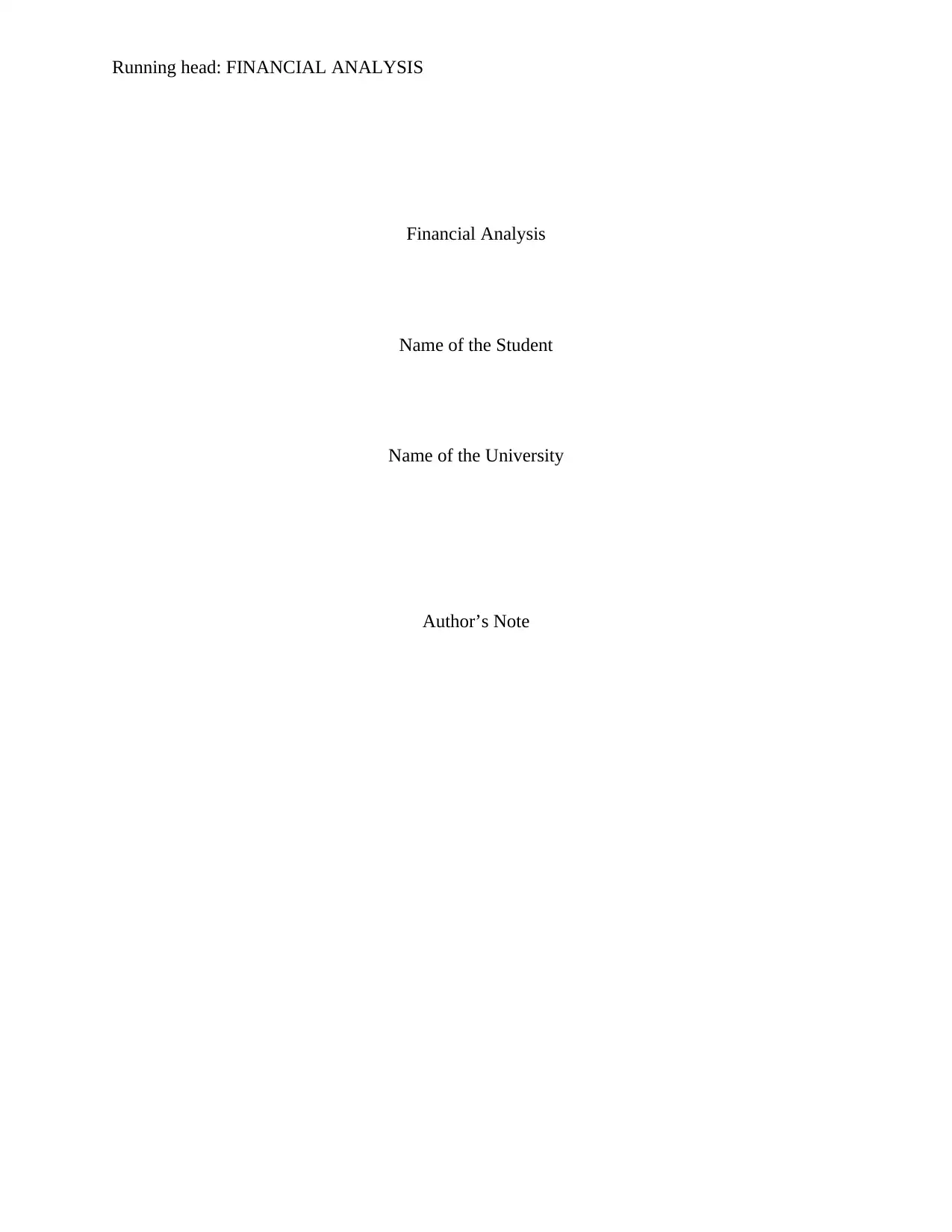
Running head: FINANCIAL ANALYSIS
Financial Analysis
Name of the Student
Name of the University
Author’s Note
Financial Analysis
Name of the Student
Name of the University
Author’s Note
Paraphrase This Document
Need a fresh take? Get an instant paraphrase of this document with our AI Paraphraser
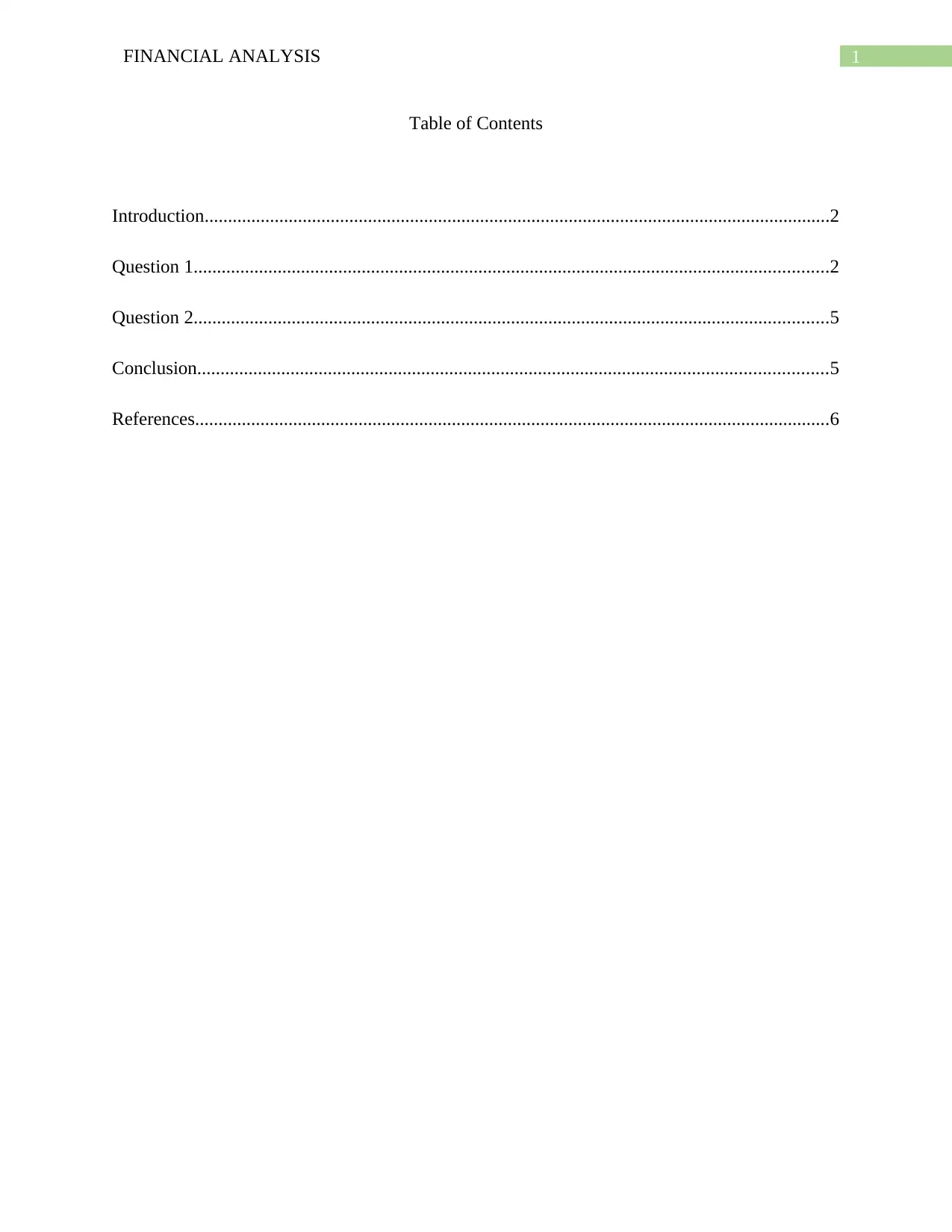
1FINANCIAL ANALYSIS
Table of Contents
Introduction......................................................................................................................................2
Question 1........................................................................................................................................2
Question 2........................................................................................................................................5
Conclusion.......................................................................................................................................5
References........................................................................................................................................6
Table of Contents
Introduction......................................................................................................................................2
Question 1........................................................................................................................................2
Question 2........................................................................................................................................5
Conclusion.......................................................................................................................................5
References........................................................................................................................................6
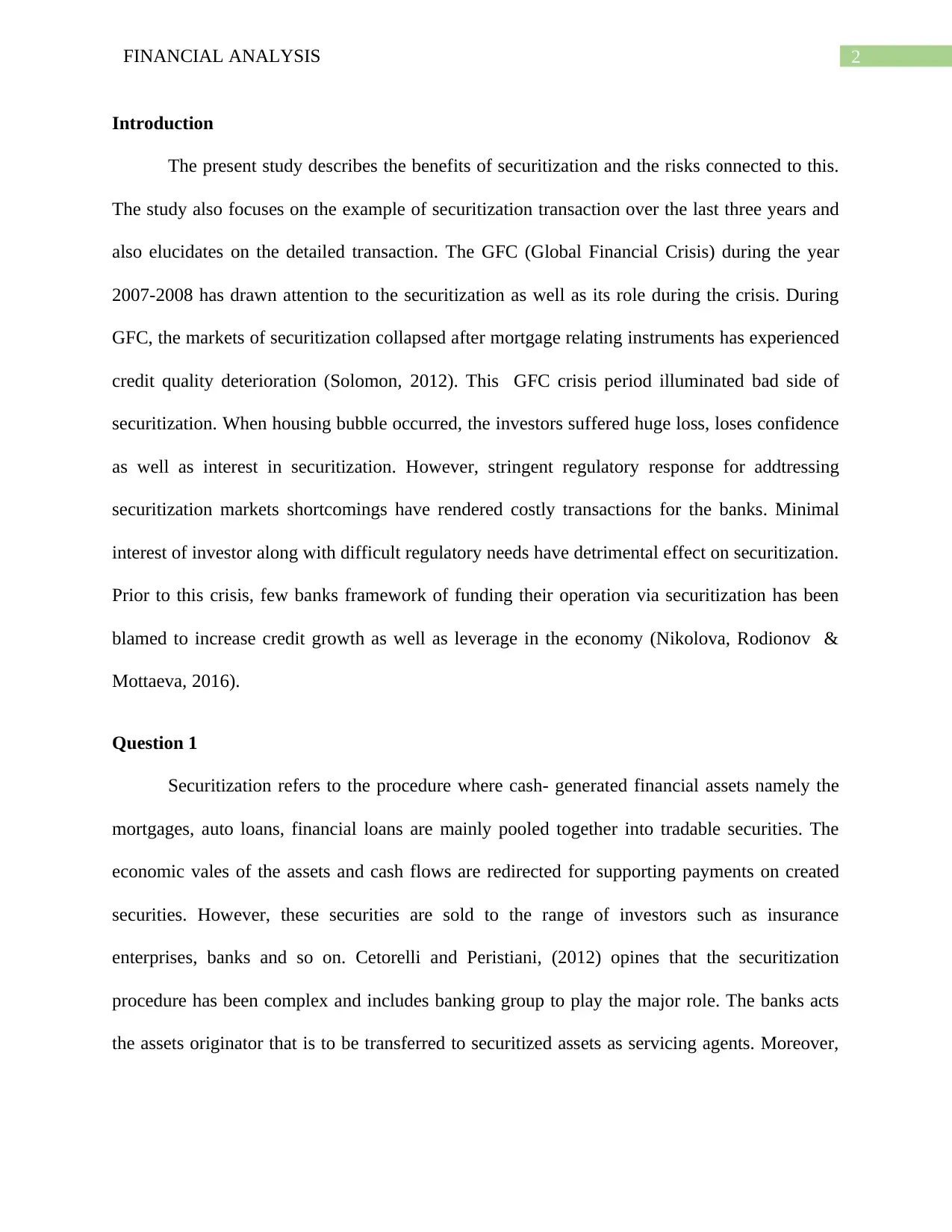
2FINANCIAL ANALYSIS
Introduction
The present study describes the benefits of securitization and the risks connected to this.
The study also focuses on the example of securitization transaction over the last three years and
also elucidates on the detailed transaction. The GFC (Global Financial Crisis) during the year
2007-2008 has drawn attention to the securitization as well as its role during the crisis. During
GFC, the markets of securitization collapsed after mortgage relating instruments has experienced
credit quality deterioration (Solomon, 2012). This GFC crisis period illuminated bad side of
securitization. When housing bubble occurred, the investors suffered huge loss, loses confidence
as well as interest in securitization. However, stringent regulatory response for addtressing
securitization markets shortcomings have rendered costly transactions for the banks. Minimal
interest of investor along with difficult regulatory needs have detrimental effect on securitization.
Prior to this crisis, few banks framework of funding their operation via securitization has been
blamed to increase credit growth as well as leverage in the economy (Nikolova, Rodionov &
Mottaeva, 2016).
Question 1
Securitization refers to the procedure where cash- generated financial assets namely the
mortgages, auto loans, financial loans are mainly pooled together into tradable securities. The
economic vales of the assets and cash flows are redirected for supporting payments on created
securities. However, these securities are sold to the range of investors such as insurance
enterprises, banks and so on. Cetorelli and Peristiani, (2012) opines that the securitization
procedure has been complex and includes banking group to play the major role. The banks acts
the assets originator that is to be transferred to securitized assets as servicing agents. Moreover,
Introduction
The present study describes the benefits of securitization and the risks connected to this.
The study also focuses on the example of securitization transaction over the last three years and
also elucidates on the detailed transaction. The GFC (Global Financial Crisis) during the year
2007-2008 has drawn attention to the securitization as well as its role during the crisis. During
GFC, the markets of securitization collapsed after mortgage relating instruments has experienced
credit quality deterioration (Solomon, 2012). This GFC crisis period illuminated bad side of
securitization. When housing bubble occurred, the investors suffered huge loss, loses confidence
as well as interest in securitization. However, stringent regulatory response for addtressing
securitization markets shortcomings have rendered costly transactions for the banks. Minimal
interest of investor along with difficult regulatory needs have detrimental effect on securitization.
Prior to this crisis, few banks framework of funding their operation via securitization has been
blamed to increase credit growth as well as leverage in the economy (Nikolova, Rodionov &
Mottaeva, 2016).
Question 1
Securitization refers to the procedure where cash- generated financial assets namely the
mortgages, auto loans, financial loans are mainly pooled together into tradable securities. The
economic vales of the assets and cash flows are redirected for supporting payments on created
securities. However, these securities are sold to the range of investors such as insurance
enterprises, banks and so on. Cetorelli and Peristiani, (2012) opines that the securitization
procedure has been complex and includes banking group to play the major role. The banks acts
the assets originator that is to be transferred to securitized assets as servicing agents. Moreover,
⊘ This is a preview!⊘
Do you want full access?
Subscribe today to unlock all pages.

Trusted by 1+ million students worldwide
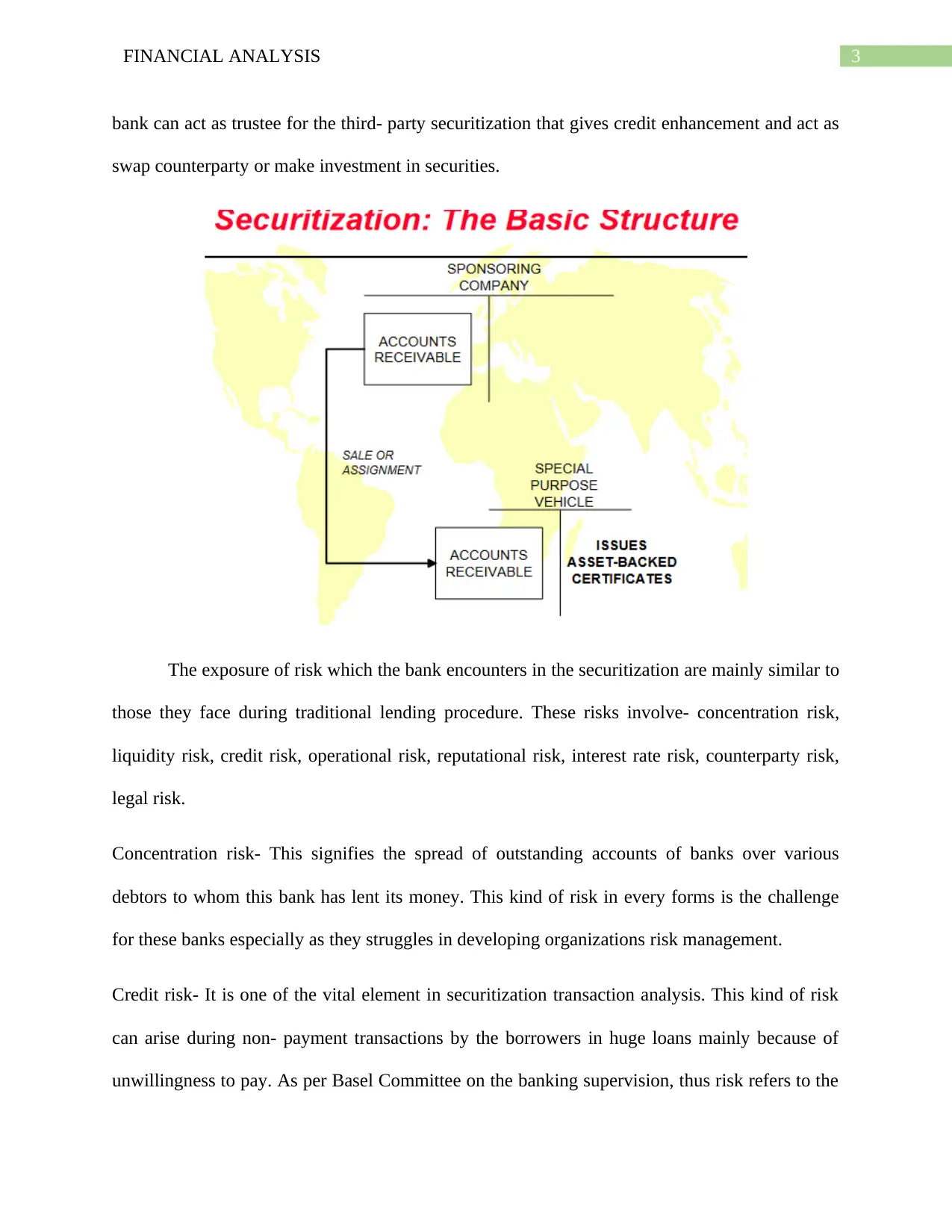
3FINANCIAL ANALYSIS
bank can act as trustee for the third- party securitization that gives credit enhancement and act as
swap counterparty or make investment in securities.
The exposure of risk which the bank encounters in the securitization are mainly similar to
those they face during traditional lending procedure. These risks involve- concentration risk,
liquidity risk, credit risk, operational risk, reputational risk, interest rate risk, counterparty risk,
legal risk.
Concentration risk- This signifies the spread of outstanding accounts of banks over various
debtors to whom this bank has lent its money. This kind of risk in every forms is the challenge
for these banks especially as they struggles in developing organizations risk management.
Credit risk- It is one of the vital element in securitization transaction analysis. This kind of risk
can arise during non- payment transactions by the borrowers in huge loans mainly because of
unwillingness to pay. As per Basel Committee on the banking supervision, thus risk refers to the
bank can act as trustee for the third- party securitization that gives credit enhancement and act as
swap counterparty or make investment in securities.
The exposure of risk which the bank encounters in the securitization are mainly similar to
those they face during traditional lending procedure. These risks involve- concentration risk,
liquidity risk, credit risk, operational risk, reputational risk, interest rate risk, counterparty risk,
legal risk.
Concentration risk- This signifies the spread of outstanding accounts of banks over various
debtors to whom this bank has lent its money. This kind of risk in every forms is the challenge
for these banks especially as they struggles in developing organizations risk management.
Credit risk- It is one of the vital element in securitization transaction analysis. This kind of risk
can arise during non- payment transactions by the borrowers in huge loans mainly because of
unwillingness to pay. As per Basel Committee on the banking supervision, thus risk refers to the
Paraphrase This Document
Need a fresh take? Get an instant paraphrase of this document with our AI Paraphraser
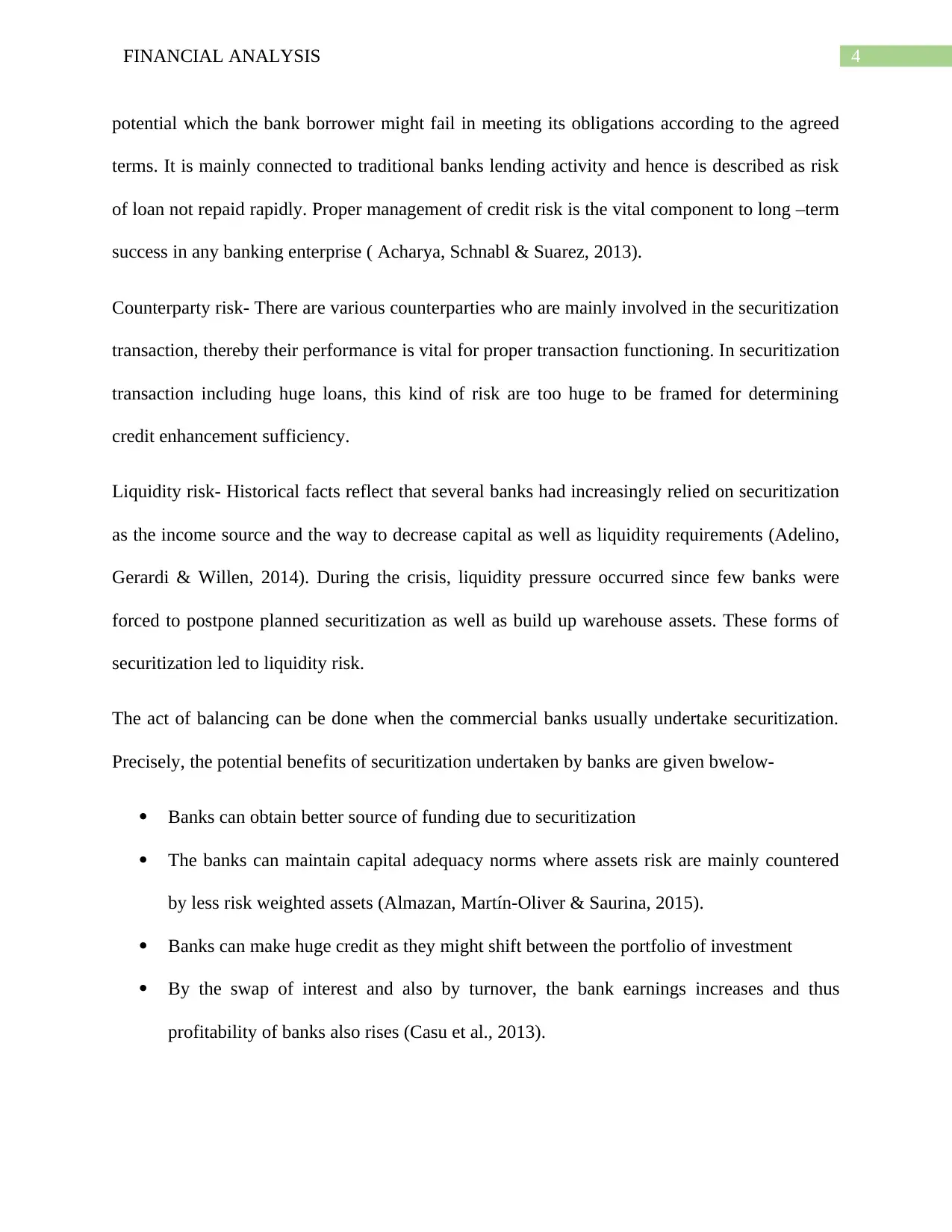
4FINANCIAL ANALYSIS
potential which the bank borrower might fail in meeting its obligations according to the agreed
terms. It is mainly connected to traditional banks lending activity and hence is described as risk
of loan not repaid rapidly. Proper management of credit risk is the vital component to long –term
success in any banking enterprise ( Acharya, Schnabl & Suarez, 2013).
Counterparty risk- There are various counterparties who are mainly involved in the securitization
transaction, thereby their performance is vital for proper transaction functioning. In securitization
transaction including huge loans, this kind of risk are too huge to be framed for determining
credit enhancement sufficiency.
Liquidity risk- Historical facts reflect that several banks had increasingly relied on securitization
as the income source and the way to decrease capital as well as liquidity requirements (Adelino,
Gerardi & Willen, 2014). During the crisis, liquidity pressure occurred since few banks were
forced to postpone planned securitization as well as build up warehouse assets. These forms of
securitization led to liquidity risk.
The act of balancing can be done when the commercial banks usually undertake securitization.
Precisely, the potential benefits of securitization undertaken by banks are given bwelow-
Banks can obtain better source of funding due to securitization
The banks can maintain capital adequacy norms where assets risk are mainly countered
by less risk weighted assets (Almazan, Martín-Oliver & Saurina, 2015).
Banks can make huge credit as they might shift between the portfolio of investment
By the swap of interest and also by turnover, the bank earnings increases and thus
profitability of banks also rises (Casu et al., 2013).
potential which the bank borrower might fail in meeting its obligations according to the agreed
terms. It is mainly connected to traditional banks lending activity and hence is described as risk
of loan not repaid rapidly. Proper management of credit risk is the vital component to long –term
success in any banking enterprise ( Acharya, Schnabl & Suarez, 2013).
Counterparty risk- There are various counterparties who are mainly involved in the securitization
transaction, thereby their performance is vital for proper transaction functioning. In securitization
transaction including huge loans, this kind of risk are too huge to be framed for determining
credit enhancement sufficiency.
Liquidity risk- Historical facts reflect that several banks had increasingly relied on securitization
as the income source and the way to decrease capital as well as liquidity requirements (Adelino,
Gerardi & Willen, 2014). During the crisis, liquidity pressure occurred since few banks were
forced to postpone planned securitization as well as build up warehouse assets. These forms of
securitization led to liquidity risk.
The act of balancing can be done when the commercial banks usually undertake securitization.
Precisely, the potential benefits of securitization undertaken by banks are given bwelow-
Banks can obtain better source of funding due to securitization
The banks can maintain capital adequacy norms where assets risk are mainly countered
by less risk weighted assets (Almazan, Martín-Oliver & Saurina, 2015).
Banks can make huge credit as they might shift between the portfolio of investment
By the swap of interest and also by turnover, the bank earnings increases and thus
profitability of banks also rises (Casu et al., 2013).
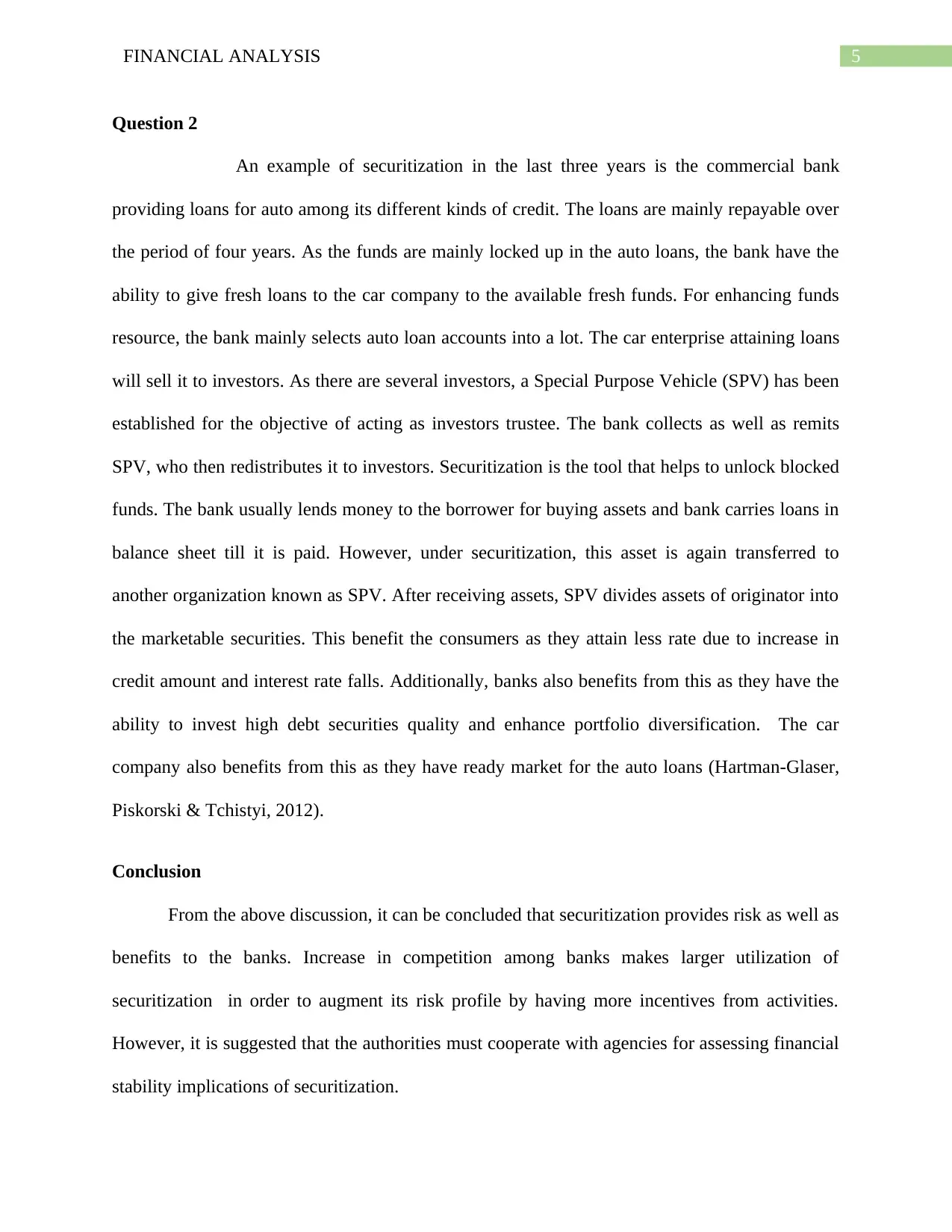
5FINANCIAL ANALYSIS
Question 2
An example of securitization in the last three years is the commercial bank
providing loans for auto among its different kinds of credit. The loans are mainly repayable over
the period of four years. As the funds are mainly locked up in the auto loans, the bank have the
ability to give fresh loans to the car company to the available fresh funds. For enhancing funds
resource, the bank mainly selects auto loan accounts into a lot. The car enterprise attaining loans
will sell it to investors. As there are several investors, a Special Purpose Vehicle (SPV) has been
established for the objective of acting as investors trustee. The bank collects as well as remits
SPV, who then redistributes it to investors. Securitization is the tool that helps to unlock blocked
funds. The bank usually lends money to the borrower for buying assets and bank carries loans in
balance sheet till it is paid. However, under securitization, this asset is again transferred to
another organization known as SPV. After receiving assets, SPV divides assets of originator into
the marketable securities. This benefit the consumers as they attain less rate due to increase in
credit amount and interest rate falls. Additionally, banks also benefits from this as they have the
ability to invest high debt securities quality and enhance portfolio diversification. The car
company also benefits from this as they have ready market for the auto loans (Hartman-Glaser,
Piskorski & Tchistyi, 2012).
Conclusion
From the above discussion, it can be concluded that securitization provides risk as well as
benefits to the banks. Increase in competition among banks makes larger utilization of
securitization in order to augment its risk profile by having more incentives from activities.
However, it is suggested that the authorities must cooperate with agencies for assessing financial
stability implications of securitization.
Question 2
An example of securitization in the last three years is the commercial bank
providing loans for auto among its different kinds of credit. The loans are mainly repayable over
the period of four years. As the funds are mainly locked up in the auto loans, the bank have the
ability to give fresh loans to the car company to the available fresh funds. For enhancing funds
resource, the bank mainly selects auto loan accounts into a lot. The car enterprise attaining loans
will sell it to investors. As there are several investors, a Special Purpose Vehicle (SPV) has been
established for the objective of acting as investors trustee. The bank collects as well as remits
SPV, who then redistributes it to investors. Securitization is the tool that helps to unlock blocked
funds. The bank usually lends money to the borrower for buying assets and bank carries loans in
balance sheet till it is paid. However, under securitization, this asset is again transferred to
another organization known as SPV. After receiving assets, SPV divides assets of originator into
the marketable securities. This benefit the consumers as they attain less rate due to increase in
credit amount and interest rate falls. Additionally, banks also benefits from this as they have the
ability to invest high debt securities quality and enhance portfolio diversification. The car
company also benefits from this as they have ready market for the auto loans (Hartman-Glaser,
Piskorski & Tchistyi, 2012).
Conclusion
From the above discussion, it can be concluded that securitization provides risk as well as
benefits to the banks. Increase in competition among banks makes larger utilization of
securitization in order to augment its risk profile by having more incentives from activities.
However, it is suggested that the authorities must cooperate with agencies for assessing financial
stability implications of securitization.
⊘ This is a preview!⊘
Do you want full access?
Subscribe today to unlock all pages.

Trusted by 1+ million students worldwide
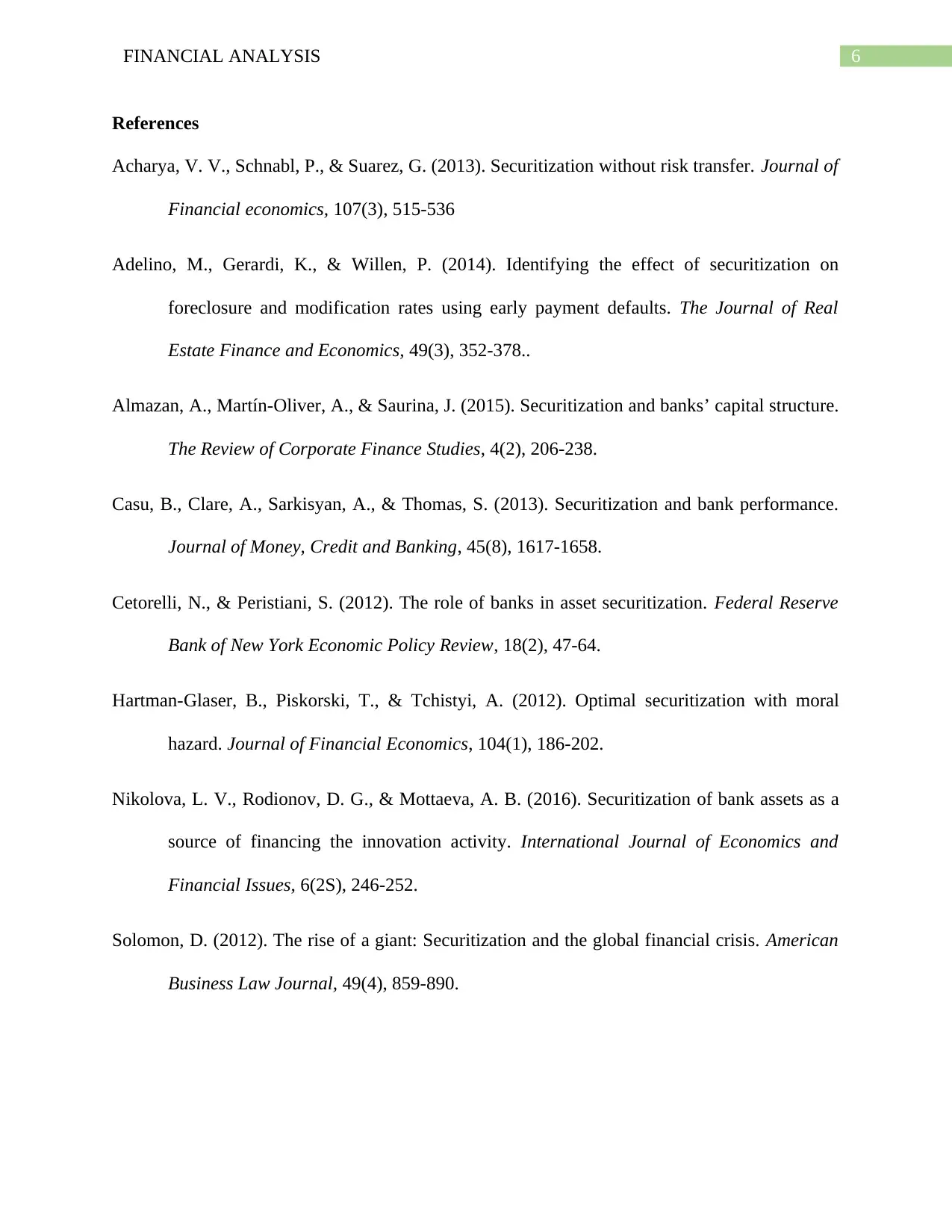
6FINANCIAL ANALYSIS
References
Acharya, V. V., Schnabl, P., & Suarez, G. (2013). Securitization without risk transfer. Journal of
Financial economics, 107(3), 515-536
Adelino, M., Gerardi, K., & Willen, P. (2014). Identifying the effect of securitization on
foreclosure and modification rates using early payment defaults. The Journal of Real
Estate Finance and Economics, 49(3), 352-378..
Almazan, A., Martín-Oliver, A., & Saurina, J. (2015). Securitization and banks’ capital structure.
The Review of Corporate Finance Studies, 4(2), 206-238.
Casu, B., Clare, A., Sarkisyan, A., & Thomas, S. (2013). Securitization and bank performance.
Journal of Money, Credit and Banking, 45(8), 1617-1658.
Cetorelli, N., & Peristiani, S. (2012). The role of banks in asset securitization. Federal Reserve
Bank of New York Economic Policy Review, 18(2), 47-64.
Hartman-Glaser, B., Piskorski, T., & Tchistyi, A. (2012). Optimal securitization with moral
hazard. Journal of Financial Economics, 104(1), 186-202.
Nikolova, L. V., Rodionov, D. G., & Mottaeva, A. B. (2016). Securitization of bank assets as a
source of financing the innovation activity. International Journal of Economics and
Financial Issues, 6(2S), 246-252.
Solomon, D. (2012). The rise of a giant: Securitization and the global financial crisis. American
Business Law Journal, 49(4), 859-890.
References
Acharya, V. V., Schnabl, P., & Suarez, G. (2013). Securitization without risk transfer. Journal of
Financial economics, 107(3), 515-536
Adelino, M., Gerardi, K., & Willen, P. (2014). Identifying the effect of securitization on
foreclosure and modification rates using early payment defaults. The Journal of Real
Estate Finance and Economics, 49(3), 352-378..
Almazan, A., Martín-Oliver, A., & Saurina, J. (2015). Securitization and banks’ capital structure.
The Review of Corporate Finance Studies, 4(2), 206-238.
Casu, B., Clare, A., Sarkisyan, A., & Thomas, S. (2013). Securitization and bank performance.
Journal of Money, Credit and Banking, 45(8), 1617-1658.
Cetorelli, N., & Peristiani, S. (2012). The role of banks in asset securitization. Federal Reserve
Bank of New York Economic Policy Review, 18(2), 47-64.
Hartman-Glaser, B., Piskorski, T., & Tchistyi, A. (2012). Optimal securitization with moral
hazard. Journal of Financial Economics, 104(1), 186-202.
Nikolova, L. V., Rodionov, D. G., & Mottaeva, A. B. (2016). Securitization of bank assets as a
source of financing the innovation activity. International Journal of Economics and
Financial Issues, 6(2S), 246-252.
Solomon, D. (2012). The rise of a giant: Securitization and the global financial crisis. American
Business Law Journal, 49(4), 859-890.
1 out of 7
Related Documents
Your All-in-One AI-Powered Toolkit for Academic Success.
+13062052269
info@desklib.com
Available 24*7 on WhatsApp / Email
![[object Object]](/_next/static/media/star-bottom.7253800d.svg)
Unlock your academic potential
Copyright © 2020–2025 A2Z Services. All Rights Reserved. Developed and managed by ZUCOL.





